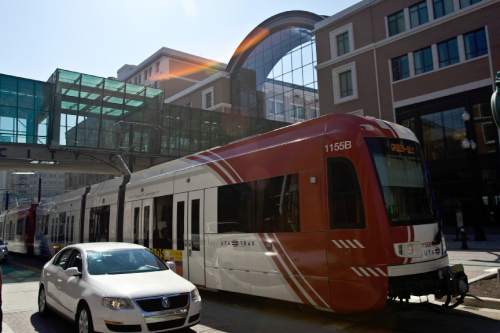This is an archived article that was published on sltrib.com in 2015, and information in the article may be outdated. It is provided only for personal research purposes and may not be reprinted.
The Utah Transit Authority Board set a new official goal for 2016: improve public trust and accountability.
That was included in a set of seven goals approved this week by the UTA Board for 2016, and comes after a state audit last year criticized the agency for sweetheart deals with developers, high salaries and bonuses, and extensive executive travel.
Normally, executives would need to achieve the goals set by the board to earn bonuses. But top executives earlier this month voluntarily gave up bonuses for two years, and asked that the money saved go to help provide more service.
The top executive team wrote to the board that "the absence of incentive pay will not lessen our commitment to accomplishing the 2016 goals. We believe in accountability and will work toward the objectives you have identified."
The new goal also comes as voters are deciding on Proposition 1, which would raise sales taxes for transportation and transit. Forty percent of the money in Wasatch Front counties would go to UTA. Prop 1 critics have focused their attacks primarily on UTA's pay, travel and management.
As part of the new goal to improve public trust, the UTA board approved plans to measure progress by creating and conducting "a state-of-the-art survey process" designed "to gauge sentiment regarding trust, accountability and confidence in UTA."
Documents said those surveys would be conducted "among riders, public/non-riders, and policy makers." It also said UTA will "develop an action plan based on results, and re-survey annually to demonstrate improvement."
Among other 2016 goals are:
• Increase ridership by 2.5 percent over 2015. This year, UTA had set a goal to increase ridership by 3.3 percent over all-time record levels in 2014, but through August it was up only slightly by 0.1 percent.
• Maximize ridership and passenger revenue, and lower operating costs. That is measured by how much subsidy UTA provides per ride, which the agency calls "investment per rider." The final target for that won't be set until the 2016 budget is finalized, said UTA spokesman Remi Barron.
The subsidy this year — or the cost not covered by fares — has been $3.81 per ride so far. That is well below the 2015 goal subsidy of $4.01 or less.
• Raise $15.2 million in grants.
• Help plan for more transit- oriented development around stations, including completing at least two station-area plans with regional development agencies for that purpose.
• Increase electronic fare collection, and simplify the fare structure.
• Improve access to the UTA system with more "first mile/last mile" projects to help people get to bus and train stations more easily — which previously has included partnerships to provide such things as bike rentals, Lyft or Uber rides, or trails. The goal calls for completion of at least three such projects next year.
The UTA Board receives monthly updates about progress on goals.



